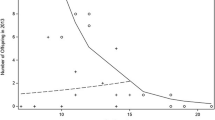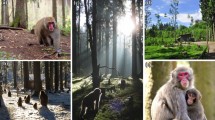Abstract
Wild Japanese macaque females of the Yakushima and Kinkazan populations exhibited similar reproductive features. (1) Births/female/year (BR: 0.27–0.35) was lower than those of provisioned troops, but (2) infant mortality (IM: 0.23–0.25) was higher than those of provisioned troops. (3) The interbirth interval (IBI) following the death of infants was 1.5–1.6 years, shorter than that following surviving infants (2.2–2.4 yrs). (4) Birth sex ratio (BSR) did not differ from 1∶1. There was no consistent correlation between (5) female age and IM, (6) maternal rank and offspring BSR, or (7) maternal rank and reproductive success. On the other hand, (8) BR of Yakushima females was significantly lower than that of Kinkazan females. In particular, (9) Yakushima females stopped reproduction earlier than Kinkazan females, although (10) the first birth of Yakushima females was about one year earlier than Kinkazan females. (11) BR exhibited a humped curve against female age in Yakushima, but it was uncertain whether old-aged females of Kinkazan exhibited a post-reproductive life span (PRLS). (12) The survivorship for female juveniles was lower than that for male juveniles in Yakushima, whereas the survivorship for male juveniles was lower than that for female juveniles in Kinkazan. These data may indicate that Yakushima females more severely compete for resources than Kinkazan females, because of high population density, whereas the population density of Kinkazan might be limited by climate (e.g. heavy snow) rather than density dependent ecological effects.
Similar content being viewed by others
References
Cheney, D. L.;Seyfarth, R. M.;Andelman, S. J.;Lee, P. C. 1988. Reproductive success in vervet monkeys. In:Reproductive Success,Clutton-Brock,T. H. (ed.), Univ. of Chicago Press, Chicago, pp. 384–402.
Drickamer, L. C. 1974. A ten-year summary of reproductive data for free-rangingMacaca mulatta.Folia Primatol., 21: 61–80.
Fedigan, L. M. 1983. Dominance and reproductive success in primates.Ybk. Phys. Anthropol., 26: 91–129.
Fedigan, L. M.;Fedigan, L.;Gouzoules, S.;Gouzoules, H.;Koyama, N. 1986. Lifetime reproductive success in female Japanese macaques.Folia Primatol., 47: 143–157.
Harcourt, A. H. 1987. Dominance and fertility among female primates.J. Zool. Lond., 213: 471–487.
Hill, D. A.;Okayasu, N. 1995. Absence of ‘youngest ascendency’ in the dominance relations of sisters in wild Japanese macaques (Macaca fuscata yakui).Behaviour, 132: 367–379.
Itoigawa, N.;Tanaka, T.;Ukai, N.;Fujii, H.;Kurokawa, T.;Koyama, T.;Ando, A.;Watanabe, Y.;Imakawa, S. 1992. Demography and reproductive parameters of a free-ranging group of Japanese macaques (Macaca fuscata) at Katsuyama.Primates, 33: 49–68.
Izawa, K. 1988. The ecological study of wild Japanese monkeys living in Kinkazan Island, Miyagi Prefecture: on the population change and the group division.Bull. Miyagi Univ. Edu., 23: 1–9. (in Japanese with English Summary)
Izawa, K. 1992. The ecological study of wild Japanese monkeys living in Kinkazan Island, Miyagi Prefecture: on the change of birth rate and infant mortality (a supplement).Bull. Miyagi Univ. Edu., 27: 69–75. (in Japanese with English Summary)
Izawa, K. 1995. The ecological study of wild Japanese monkeys living in Kinkazan Island, Miyagi Prefecture: on the population change in recent three years.Bull. Miyagi Univ. Edu., 30: 147–157. (in Japanese with English Summary)
Koyama, N.;Takahata, Y.;Huffman, M. A.;Norikoshi, K.;Suzuki, H. 1992. Reproductive parameters of female Japanese macaques: thirty years data from the Arashiyama troops, Japan.Primates, 33: 33–47.
Maruhashi, T. 1982. An ecological study of troop fissions of Japanese monkeys (Macaca fuscata yakui) on Yakushima Island, Japan.Primates, 23: 317–337.
Nakagawa, N. 1989. Bioenergetics of Japanese monkeys (Macaca fuscata) on Kinkazan Island during winter.Primates, 30: 441–460.
van Schaik, C. P.;Hrdy, S. B. 1991. Intensity of local resource competition shapes the relationship between maternal rank and sex ratios at birth in cercopithecine primates.Amer. Naturalist, 138: 1555–1562.
van Schaik, C. P.;Netto, W. J.;van Amerongen, A. J. J.;Westland, H. 1989. Social rank and sex ratio of captive long-tailed macaque females (Macaca fascicularis).Amer. J. Primatol., 19: 147–161.
van Schaik, C. P.;de Visser, J. A. G. M. 1990. Fragile sons or harassed daughters?: sex differences in mortality among juvenile primates.Folia Primatol., 55: 10–23.
Silk, J. A. 1983. Local resource competition and facultative adjustment of sex ratios in relation to competitive abilities.Amer. Naturalist, 121: 56–66.
Smuts, B. B.;Nicolson, N. 1989. Reproduction in wild female olive baboons.Amer. J. Primatol., 19: 229–246.
Sugiyama, Y.;Ohsawa, H. 1982. Population dynamics of Japanese monkeys with special reference to the effect of artificial feeding.Folia Primatol., 39: 238–263.
Suzuki, A.;Wada, K.;Yoshihiro, S.;Tokita, E.;Hara, S.;Aburada, Y. 1975. Population dynamics and group movement of Japanese monkeys in Yokoyugawa Valley, Shiga Heights.Phys. Ecol., 16: 15–23. (in Japanese)
Takahata, Y.;Koyama, N.;Huffman, M. A.;Norikoshi, K.;Suzuki, H. 1995a. Are daughters more costly to produce for Japanese macaque mothers?: sex of the offspring and subsequent interbirth intervals.Primates, 36: 571–574.
Takahata, Y.;Koyama, N.;Suzuki, S. 1995b. Do the old aged females experience a long post-reproductive life span?: the cases of Japanese macaques and chimpanzees.Primates, 36: 169–180.
Takahata, Y.;Suzuki, S.;Okayasu, N.;Hill, D. 1994. Troop extinction and fusion in wild Japanese macaques of Yakushima Island, Japan.Amer. J. Primatol., 33: 317–322.
Trivers, R. L.;Willard, D. E. 1973. Natural selection of parental ability of vary the sex ratio of offspring.Science, 179: 90–92.
Wolfe, L. D. 1984. Female rank and reproductive success among Arashiyama B Japanese macaques (Macaca fuscata).Int. J. Primatol., 5: 133–143.
Author information
Authors and Affiliations
About this article
Cite this article
Takahata, Y., Suzuki, S., Agetsuma, N. et al. Reproduction of wild Japanese macaque females of Yakushima and Kinkazan Islands: A preliminary report. Primates 39, 339–349 (1998). https://doi.org/10.1007/BF02573082
Received:
Accepted:
Issue Date:
DOI: https://doi.org/10.1007/BF02573082




